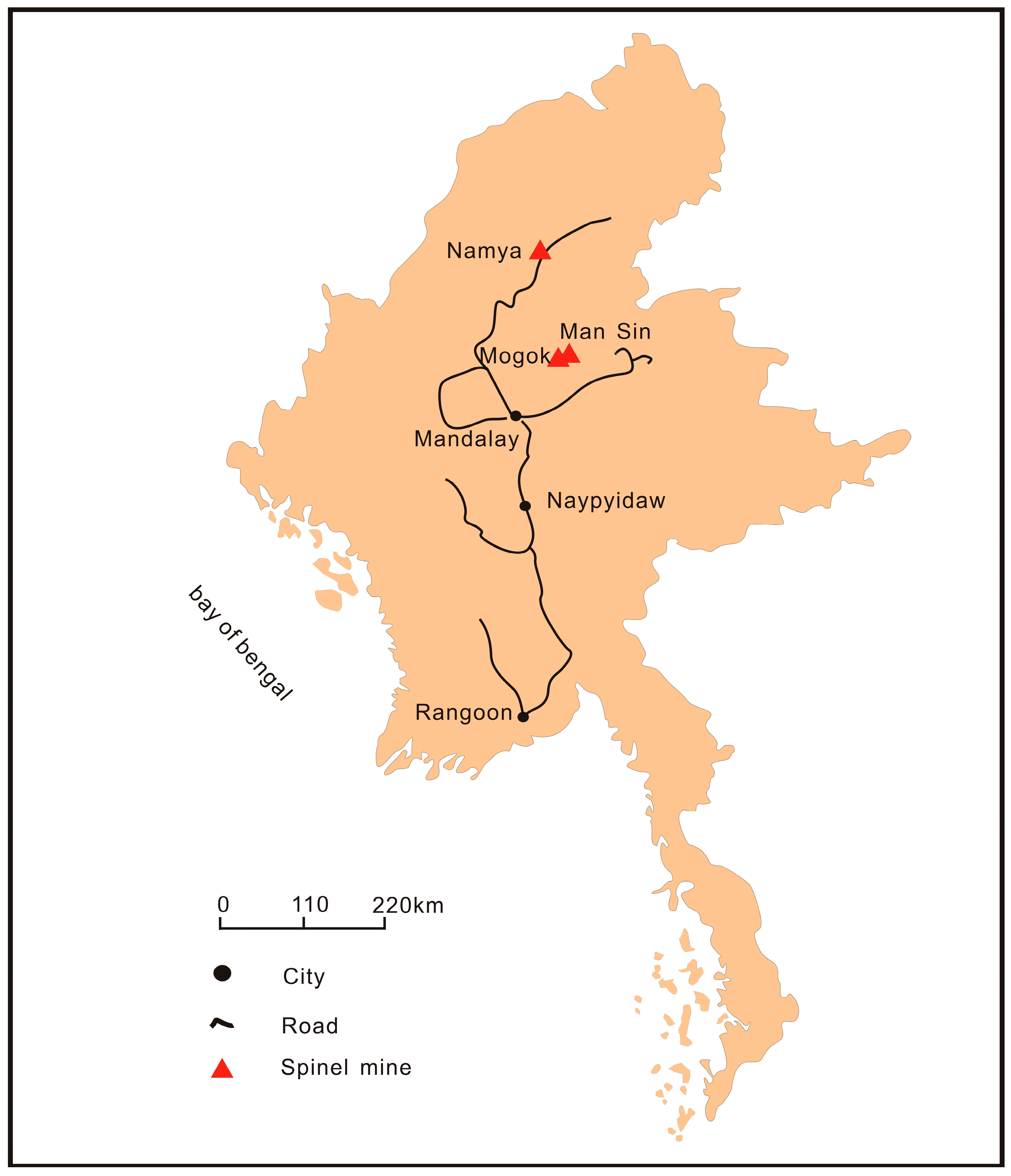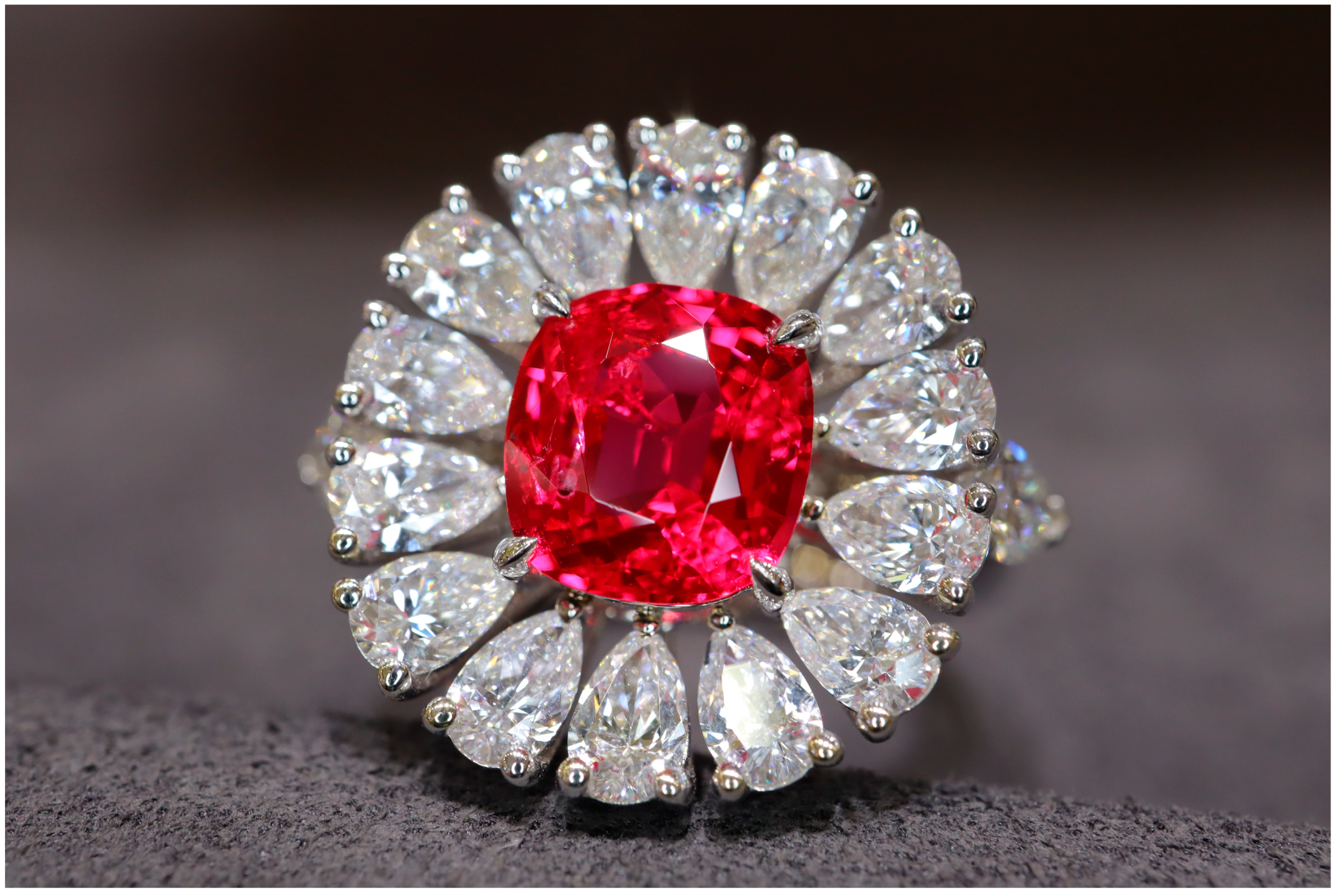Jedi Spinel from Man Sin, Myanmar: Color, Inclusion, and Chemical Features
Abstract
:1. Introduction
2. Mining and Production
3. Materials and Methods
3.1. Materials
3.2. Methods
3.2.1. Standard Gemology
3.2.2. Trace Element Analysis
3.2.3. Inclusion Analysis
4. Results
4.1. Gemological Properties
4.2. Crystal Habit and Morphology
4.3. Color
4.4. Fluorescence
4.5. Inclusions and Micro–Raman Results
4.5.1. Phlogopite
4.5.2. Molybdenite
4.5.3. Sulfur
4.5.4. Stibnite
4.5.5. Hauerite
4.5.6. Calcite
4.5.7. Unidentified Dark Crystal Surrounded by “Halo”
4.6. Chemistry
5. Discussion
5.1. Inclusions and Formation of Spinel
5.2. Color and Fluorescence
6. Jedi Spinel Fever in the Asian Market
7. Conclusions
Author Contributions
Funding
Acknowledgments
Conflicts of Interest
References
- Pardieu, V. Hunting for Jedi Spinels in Mogok. Gems Gemol. 2014, 50, 46–56. [Google Scholar] [CrossRef]
- Peretti, A.; Mullis, J.; Franz, L.; Capitani, C.; Mathys, D.; Günther, D. Spinel formation by sulphur–rich saline brines from Mansin (Mogok area, Myanmar). In Proceedings of the 15th Swiss Geoscience Meeting, Davos, Germany, 17–18 November 2017. [Google Scholar] [CrossRef]
- Phyo, M.M.; Bieler, E.; Franz, L.; Balmer, W.; Krzemnicki, M.S. Spinel from Mogok, Myanmar—A Detailed Inclusion Study by Raman Microspectroscopy and Scanning Electron Microscopy. J. Gemol. 2019, 36, 418–435. [Google Scholar] [CrossRef]
- Pardieu, V.; Hughes, R.W. Spinel: Resurrection of a classic. InColor 2008, 2, 10–18. [Google Scholar]
- Balocher, F. The Spinels of Mogok A Brief Overview. Incolor 2019, 43, 34–39. [Google Scholar]
- Malsy, A.; Klemm, L. Distinction of Gem Spinels from the Himalayan Mountain Belt. Chimia 2010, 64, 741–746. [Google Scholar] [CrossRef] [PubMed]
- Shigley, J.E.; Laurs, B.M.; Janse, A.J.A. Gem Localities of the–2000S. Gems Gemol. 2010, 46, 188–216. [Google Scholar] [CrossRef]
- Chankhantha, C.; Amphon, R.; Rehman, H.; Shen, A. Characterisation of Pink–to–Red Spinel from Four Important Localities. J. Gemmol. 2020, 37, 393–403. [Google Scholar] [CrossRef]
- Giuliani, G.; Ohnenstetter, D.; Fallick, A.E.; Groat, L.; Fagan, A. The Geology and Genesis of Gem Corundum Deposits. In Geology of Gem Deposits; Mineralogical Association of Canada Short Course Series, 44; Mineralogical Association of Canada: Tucson, AZ, Canada, 2014; pp. 35–112. [Google Scholar]
- Zaw, K. Overview of Mineralization Styles and Tectonic–metallogenic Setting in Myanmar. Geol. Soc. Lond. Mem. 2017, 48, 531–556. [Google Scholar] [CrossRef]
- Mitchell, A. Geological Belts, Plate Boundaries, and Mineral Deposits in Myanmar. Econ. Geol. 2018, 113, 1219–1220. [Google Scholar]
- Gübelin, E.J. The Ruby Mines in Mogok in Burma. J. Gemmol. 1965, 9, 411–426. [Google Scholar] [CrossRef]
- Keller, P.C. The Rubies of Burma: A Review of the Mogok Stone Tract. Gems Gemol. 1983, 19, 209–219. [Google Scholar] [CrossRef]
- Kane, R.E.; Kammerling, R.C. Status of Ruby and Sapphire Mining in the Mogok Stone Tract. Gems Gemol. 1992, 28, 152–174. [Google Scholar] [CrossRef]
- Hu, Z.C.; Gao, S.; Liu, Y.S.; Hu, S.H.; Chen, H.H.; Yuan, H.L. Signal enhancement in laser ablation ICP–MS by addition of nitrogen in the central channel gas. J. Anal. At. Spectrom. 2008, 23, 1093–1101. [Google Scholar] [CrossRef]
- Liu, Y.S.; Gao, S.; Hu, Z.C.; Gao, C.G.; Zong, K.Q.; Wang, D.B. Continental and oceanic crust recycling–induced melt–peridotite interactions in the Trans–North China orogen: U\Pb dating, Hf isotopes and trace elements in zircons from mantle xenoliths. J. Petrol. 2010, 51, 537–571. [Google Scholar] [CrossRef]
- Liu, Y.S.; Hu, Z.C.; Gao, S.; Gunther, D.; Xu, J.; Gao, C.G.; Chen, H.H. In situ analysis of major and trace elements of anhydrous minerals by LA–ICP–MS without applying an internal standard. Chem. Geol. 2008, 257, 34–43. [Google Scholar] [CrossRef]
- Andreozzi, G.B.; D’Ippolito, V.; Skogby, H.; Hålenius, U.; Bosi, F. Color mechanisms in spinel: A multi–analytical investigation of natural crystals with a wide range of coloration. Phys. Chem. Miner. 2019, 46, 343–360. [Google Scholar] [CrossRef]
- Mikenda, W.; Preisinger, A. N–lines in the luminescence spectra of Cr spinels (I) identification of N–lines. J. Lumin 1981, 26, 53–66. [Google Scholar] [CrossRef]
- Malíčková, I.; Bačík, P.; Fridrichová, J.; Hanus, R.; Štubňa, J.; Milovská, S.; Škoda, R. Detailed luminescence spectra interpretation of selected oxides: Spinel from Myanmar and chrysoberyl—Var. alexandrite from Tanzania. Acta Geol. Slovaca 2020, 12, 69–74. [Google Scholar]
- Malíčková, I.; Bačík, P.; Fridrichová, J.; Hanus, R.; Illášová, L.; Štubňa, J.; Furka, D.; Furka, S.; Škoda, R. Optical and Luminescence Spectroscopy of Varicolored Gem Spinel from Mogok, Myanmar and Lục Yên, Vietnam. Minerals 2021, 11, 169. [Google Scholar] [CrossRef]
- Shevell, S. The Science of Colour; Elsevier Science Ltd.: Amsterdam, The Netherlands, 2003. [Google Scholar]
- Manutchehrdanai, M. Dictionary of Gems and Gemology; Springer: Berlin/Heidelberg, Germany, 2005. [Google Scholar]
- Vertriest, W.; Raynaud, V. Complex Yellow Fluid Inclusions in Red Burmese Spinel. Gems Gemol. 2017, 53, 468. [Google Scholar]
- Zhai, S.; Pei, J.; Huang, W. Orange–Yellow Inclusion in Spinel from Man Sin, Myanmar. J. Gems Gemmol. 2019, 21, 24–30. [Google Scholar]
- Zhang, Y.; Zhu, J. –R.; Yu, X.–Y. A Comparative Study of the Gemological Characteristics and Inclusions in Spinels from Myanmar and Tajikistan. Crystals 2022, 12, 617. [Google Scholar] [CrossRef]
- Hughes, E.B.; Koivula, J.I.; Renfro, N.; Manorotkul, W.; Hughes, R.W. Spinel inclusions: An exercise in aesthetics. Incolor 2019, 43, 66–73. [Google Scholar]
- Phyo, M.M.; Wang, H.A.O.; Guillong, M.; Berger, A.; Franz, L.; Balmer, W.A.; Krzemnicki, M.S. U–Pb Dating of Zircon and Zirconolite Inclusions in Marble–Hosted Gem–Quality Ruby and Spinel from Mogok, Myanmar. Minerals 2020, 10, 195. [Google Scholar] [CrossRef] [Green Version]
- Khowpong, C. Chondrodite in Red Spinel from Mogok, Myanmar. Gems Gemol. 2021, 57, 383. [Google Scholar]
- Giuliani, G.; Fallick, A.E.; Boyce, A.J.; Pardieu, V.; Pham, V.L. Pink and red spinels in marble: Trace elements, oxygen isotopes, and sources. Can. Mineral. 2017, 55, 743–761. [Google Scholar] [CrossRef]
- Giuliani, G.; Fallick, A.E.; Boyce, A.J.; Pardieu, V.; Pham, V.L. Pink and Red Gem Spinels in Marble and Placers. Incolor 2019, 43, 14–28. [Google Scholar]
- Mills, S.J.; Hatert, F.; Nickel, E.H.; Ferraris, G. The standardisation of mineral group hierarchies: Application to recent nomenclature proposals. Eur. J. Mineral. 2009, 21, 1073–1080. [Google Scholar] [CrossRef]
- Bosi, F.; Biagioni, C.; Pasero, M. Nomenclature and classification of the spinel supergroup. Eur. J. Mineral. 2018, 31, 183–192. [Google Scholar] [CrossRef]
- Baidu Index. 2021. Available online: https://index.baidu.com/v2/main/index.html#/crowd/尖晶石?words=尖晶石 (accessed on 4 August 2021).
- Guild. Guild Chinese Spinel Market Report 2021. Gemol. Front. 2021, 2, 211–223. [Google Scholar]




























| No. | Number of Samples | Origin | Weight/ct | Shape | Color | No. of Samples in Each Test | |||
|---|---|---|---|---|---|---|---|---|---|
| Standard Gemology | Microscopic Observation and Photography | EDXRF | Raman | ||||||
| No. 1 | 55 | Man Sin, Myanmar | 0.19–2.50 | Rough (54), faceted (1) | Pink to red | 55 | 7 | 13 | 7 |
| No. 2 | 23 | Man Sin, Myanmar | 1.40–2.22 | Rough | Pink to red | 23 | 15 | 10 | 15 |
| No. 3 | 24 | Mogok, Myanmar | 0.42–1.49 | Rough (22), faceted (2) | Pink to red with an orangy and purplish hue | – | – | 24 | – |
| No. 4 | 30 | Namya, Myanmar | 0.39–1.28 | Rough (29), faceted (1) | Pink to red | – | – | 30 | – |
| Color | Pink to red color with a bright tone |
| Clarity | Very slightly to heavily included |
| Refractive index | 1.718 |
| Optical character | Isotopic |
| Specific gravity | 3.60 on average |
| Fluorescence | Usually exceptionally strong red fluorescence |
| Crystal habit and morphology | Octahedral crystal habit with inverted triangular etches on the (111) surface Step–like growth lines on (111) surface |
| Internal features | Near–colorless subhedral to well–formed phlogopite crystals Euhedral opaque molybdenite crystal Dark sulfide minerals, such as hauerite Yellow sulfur Unidentified dark crystal surrounded by a halo Unidentified dark mineral near the sulfur |
| Mineral | References |
|---|---|
| Molybdenite | This study; [3] |
| Stibnite | This study |
| Hauerite | This study |
| Pyrrhotite | [3] |
| Marcasite | [3] |
| Sulfur | This study, [3,24,25] |
| Phlogopite | This study, [3] |
| Calcite | This study, [3,26] |
| Dolomite | [3,26] |
| Apatite | [26,27] |
| Zircon | [3,28] |
| Zirconolite | [28] |
| Fluorophlogopite | [27] |
| Chondrodite | [29] |
| Pyrite | [26] |
| Man Sin, Myanmar * | Man Sin, Myanmar ** | Namya, Myanmar * | Mogok, Myanmar * | |||||
| Number of sample analyses | 23 | – | 30 | 24 | ||||
| Trace elements (ppm) | Range | Mean | – | Range | Mean | Range | Mean | Detection Limit |
| Ti | 277–776 | 504 | 910 | 81–1727 | 643 | 91–1018 | 318 | 2.0 |
| V | 273–609 | 398 | 408 | 84–879 | 530 | 249–2229 | 1280 | 1.0 |
| Cr | 3655–8097 | 5678 | 4174 | 833–7160 | 4242 | 2222–7798 | 4591 | 1.0 |
| Fe | 114–360 | 187 | 140 | 151–1539 | 471 | 605–3325 | 1917 | 1.0 |
| Zn | 23–256 | 134 | 70 | 145–883 | 479 | 1343–4407 | 2796 | 0.5 |
| Ga | b.d.l.–249 | 60 | – | b.d.l.–204 | 67 | b.d.l.–550 | 280 | 0.5 |
| Sample No. | 1 | 2 | 3 | 4 | Detection Limit |
|---|---|---|---|---|---|
| Mine | Mogok | Mogok | Man Sin | Namya | |
| Ti | 196 | 39 | 868 | 75 | 2.0 |
| V | 964 | 419 | 622 | 279 | 1.0 |
| Cr | 10,190 | 6066 | 9333 | 5748 | 1.0 |
| Fe | 1606 | 1531 | 329 | 270 | 1.0 |
| Zn | 6333 | 2537 | 107 | 1136 | 0.5 |
| Cr/Fe | 6.3 | 4.0 | 28.4 | 21.3 | – |
| Fluorescence Strength | Medium | Medium | Exceptionally strong | Exceptionally strong | – |
Disclaimer/Publisher’s Note: The statements, opinions and data contained in all publications are solely those of the individual author(s) and contributor(s) and not of MDPI and/or the editor(s). MDPI and/or the editor(s) disclaim responsibility for any injury to people or property resulting from any ideas, methods, instructions or products referred to in the content. |
© 2023 by the authors. Licensee MDPI, Basel, Switzerland. This article is an open access article distributed under the terms and conditions of the Creative Commons Attribution (CC BY) license (https://creativecommons.org/licenses/by/4.0/).
Share and Cite
Gao, Y.; He, M.; Sun, X.; Zhen, C.; Li, H.; Wei, X.; Zhao, Y. Jedi Spinel from Man Sin, Myanmar: Color, Inclusion, and Chemical Features. Crystals 2023, 13, 103. https://doi.org/10.3390/cryst13010103
Gao Y, He M, Sun X, Zhen C, Li H, Wei X, Zhao Y. Jedi Spinel from Man Sin, Myanmar: Color, Inclusion, and Chemical Features. Crystals. 2023; 13(1):103. https://doi.org/10.3390/cryst13010103
Chicago/Turabian StyleGao, Yujie, Mingyue He, Xueying Sun, Cuiling Zhen, Huihuang Li, Xiaotao Wei, and Yizhi Zhao. 2023. "Jedi Spinel from Man Sin, Myanmar: Color, Inclusion, and Chemical Features" Crystals 13, no. 1: 103. https://doi.org/10.3390/cryst13010103




